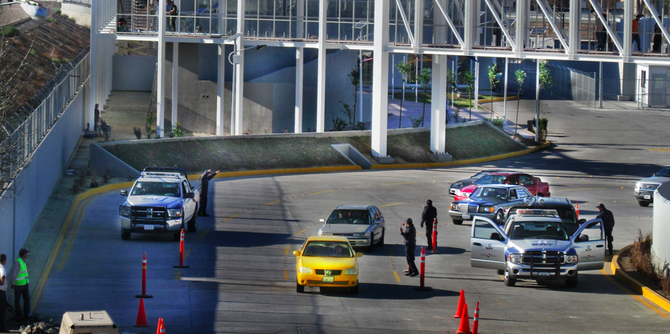 Facebook
Facebook
 X
X
 Instagram
Instagram
 TikTok
TikTok
 Youtube
Youtube

El Chaparral, Mexico’s new port of entry adjacent to San Ysidro, opened yesterday, October 24, on a test basis, with a connecter road running along the Mexican-side border fence from Interstate 5 heading west to the new port. This coming Monday, the 29th, another lane will open, and then on November 1, all five lanes to El Chaparral will be open along the recently constructed border fence “feeder route.”
The five feeder lanes will spread out into an expanse of 22 inspection lanes at the El Chaparral complex. This is the plan of the man in charge of the project, Carlos López Rodríguez, according to a recent interview in Frontera.
After the five lanes of the feeder route are opened, all Mexico-bound traffic from I-5 will be routed to El Chaparral, where, once past the 22 entry lanes of the facility, motorists will be able to select a route from four overpasses crossing the Tijuana River in order to arrive at various parts of the city.
The toughest part of the temporary feeder lane, according to López, will be negotiating the sharp curve, which allows a speed of only about 20 mph, and then traveling the narrow road for 300 meters alongside the border fence in order to arrive at the 22-lane fan-out.
One of the four overpass bridges will lead motorists to Playas de Tijuana, Rosarito, and Ensenada; another leads to La Via Rápida Poniente, which tracks the Tijuana River canal southward; a third bridge leads to the Zona Centro (downtown Tijuana); while a fourth overpass leads to the area around Pueblo Amigo (hotel).
López stressed that the five-feeder-lane plan is temporary, while awaiting the U.S. side of the border-crossing project to be completed, some two years hence, with the rerouting of I-5 directly to the 22 lanes of El Chaparral, obviating the present need for the border-fence road. López wanted to assure the public that the old Port of Mexico would be available to open for “horas pico” (rush hour) or in an emergency where a large volume of traffic needs to be handled.
On October 24, the gran apertura (grand opening) appeared successful. A contingent of officials directed the traffic at the exit end in order to ensure that the sporadic arrival of clusters of cars from the United States smoothly flowed into El Chaparral’s serpentine system of traffic distribution.


El Chaparral, Mexico’s new port of entry adjacent to San Ysidro, opened yesterday, October 24, on a test basis, with a connecter road running along the Mexican-side border fence from Interstate 5 heading west to the new port. This coming Monday, the 29th, another lane will open, and then on November 1, all five lanes to El Chaparral will be open along the recently constructed border fence “feeder route.”
The five feeder lanes will spread out into an expanse of 22 inspection lanes at the El Chaparral complex. This is the plan of the man in charge of the project, Carlos López Rodríguez, according to a recent interview in Frontera.
After the five lanes of the feeder route are opened, all Mexico-bound traffic from I-5 will be routed to El Chaparral, where, once past the 22 entry lanes of the facility, motorists will be able to select a route from four overpasses crossing the Tijuana River in order to arrive at various parts of the city.
The toughest part of the temporary feeder lane, according to López, will be negotiating the sharp curve, which allows a speed of only about 20 mph, and then traveling the narrow road for 300 meters alongside the border fence in order to arrive at the 22-lane fan-out.
One of the four overpass bridges will lead motorists to Playas de Tijuana, Rosarito, and Ensenada; another leads to La Via Rápida Poniente, which tracks the Tijuana River canal southward; a third bridge leads to the Zona Centro (downtown Tijuana); while a fourth overpass leads to the area around Pueblo Amigo (hotel).
López stressed that the five-feeder-lane plan is temporary, while awaiting the U.S. side of the border-crossing project to be completed, some two years hence, with the rerouting of I-5 directly to the 22 lanes of El Chaparral, obviating the present need for the border-fence road. López wanted to assure the public that the old Port of Mexico would be available to open for “horas pico” (rush hour) or in an emergency where a large volume of traffic needs to be handled.
On October 24, the gran apertura (grand opening) appeared successful. A contingent of officials directed the traffic at the exit end in order to ensure that the sporadic arrival of clusters of cars from the United States smoothly flowed into El Chaparral’s serpentine system of traffic distribution.
Comments